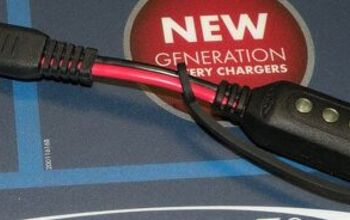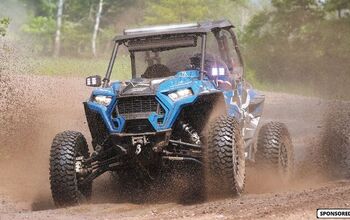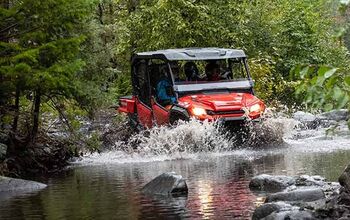How to Maximize Your ATV/UTV and Tow Rig’s Fuel Economy

Your tow rig might be for work and ATV or UTV might be for play, but chances are that both use internal combustion engines and that you want both to perform their best. Performance and fuel economy might not sound like they go hand-in-hand, and yet they do; efficiency isn’t relegated to saving gas, but it helps keep performance at its peak as well. Let’s explore some tips and tricks to get the most out of your tow vehicle and off-road toy.
Tow Vehicle, Trailer, and ATV or UTV Tire Pressure
Tire pressure is absolutely vital to maintaining optimal fuel economy. Obviously that goes for underinflated tires, which results in higher rolling resistance and thus the need for more gas to be used to move the vehicle.
The best course of action is to set the tires to the manufacturer’s recommended pressure. For the tow rig, this can be found on a label on the door sill or in the owner’s manual. ATVs and UTVs usually have a similar type sticker, but that’s not always the case. In this instance, there might be some trial-and-error involved in getting the tire pressure right, but a good rule of thumb is to look at the maximum pressure on the side warning stamped on the side of the tire (assuming there is one) and cut it in half, then adjust from there. If you can’t, check with the tire manufacturer for what they recommend. Similarly, trailer tires usually have the same type of sticker, but when they don’t you should consult the tire manufacturer prior to putting the tires under load.
It must be said that overinflated tires are also a no-no. This can lead to suboptimal handling characteristics which can make for dangerous driving situations, plus it can highly increase the likelihood of a tire blowing out.
You can learn more about setting tire pressure just right in our “How Do I Adjust My Tire Pressure?” guide.
Tire Size
Those big tires might look cool, but chances are they’re killing your fuel economy. Extra rotational diameter not only takes more effort to get going, but most times an increased tire size comes with increased weight as well. More weight, too, severely harms gas mileage. Similarly, higher load rating tires may come with an increase in rolling resistance, and the same is the case with tires with aggressive treads like mud tires.
One way some people try to minimize the hit in fuel economy when going to a taller tire is to run what is commonly known as a “pizza cutter,” or one that is tall and narrow. This helps minimize the increase in additional tread touching the ground while still helping gain height and ground clearance.
Alignment
Just like with tire pressure, proper alignment is critical to maintaining optimal gas mileage. Any time the tires are misaligned, it makes for more work for the vehicle to accelerate and maintain speed. Keeping things within spec not only helps keep efficiency up, but also aids in maintaining the vehicle’s best possible handling, cornering, and subsequently safety characteristics.
Air Intake Filter
A dirty, clogged, or worn air intake filter can have a severe impact on fuel economy. An engine needs the proper amount of air (and fuel, spark, and combustion) to perform its best, so any reduction in this results in a reduction in gas mileage.
Oil
How old is the oil in your vehicle? Making sure to stay up to date on it will be a serious benefit to your engine’s smoothness, performance, efficiency, and longevity. Old oil can lead to an engine performing sub-optimally, and the same goes for an overfilled or underfilled engine.
Oil Viscosity
Just because you have enough oil doesn’t mean it’s the right kind. Running the right oil is vital to proper lubrication of the engine, which in turn helps it run its best. Consulting your owner’s manual is the best way to know which oil to run.
Proper Drivetrain Lubrication
Plain and simple, anything that causes a vehicle to not coast freely or to have any unnecessary force restraining it from its maximum acceleration is a bad thing. Keeping the appropriate joints and bearings properly lubricated not only makes it easier to drive and better performing, but helps it retain its best possible gas mileage. From u-joints to wheel bearings and everything in-between, greasing or lubricating everything that needs to be is often overlooked. It shouldn’t be.
Fuel Injectors, Spark Plugs, etc.
Basic maintenance items like spark plugs sometimes go overlooked as well, yet they are effectively the determining factor in whether the engine is performing the way it should. Similarly, fuel injectors control efficient and effective use of gas, so having everything that plays to the input side of a vehicle’s performance in good shape only benefits the outcome.
Ditch the Excess Weight
Mass is the enemy of performance and gas mileage. If you’re really out to achieve the best range and mileage, you have to minimize how much weight you’re carrying. That means that you take the essentials: this varies wildly between what you and someone else doing a different trip may need, but the general idea is minimizing what comes with you. Do you really need that full tool set and multiple replacement axles for an easy fire road ride? How about the enormous cooler with a week’s worth of ice and drinks for a short afternoon ride? Pack intelligently and leave the excess home.
Other Odds and Ends
A lot of other factors play to what determines fuel mileage. Drag is the enemy of motion, so while a roof rack looks cool, it’s actually working against you (not to mention worsening center of gravity). Similarly, accelerating smoothly, coasting to stoplights to minimize the need for acceleration from a stop, and maintaining highway speeds below 70 MPH generally all benefit your gas mileage.

Ross hosts The Off the Road Again Podcast. He has been in the off-road world since he was a kid riding in the back of his dad’s YJ Wrangler. He works in marketing by day and in his free time contributes to Hooniverse, AutoGuide, and ATV.com, and in the past has contributed to UTV Driver, ATV Rider, and Everyday Driver. Ross drives a 2018 Lexus GX460 that is an ongoing build project featured on multiple websites and the podcast and spends his free time working on and riding ATVs.
More by Ross Ballot










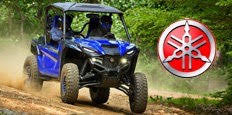


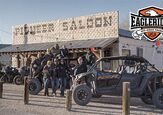






![Unique ATV Tire Bead Breaker [video]](https://cdn-fastly.atv.com/media/2022/10/24/8744118/unique-atv-tire-bead-breaker-video.jpg?size=350x220)
